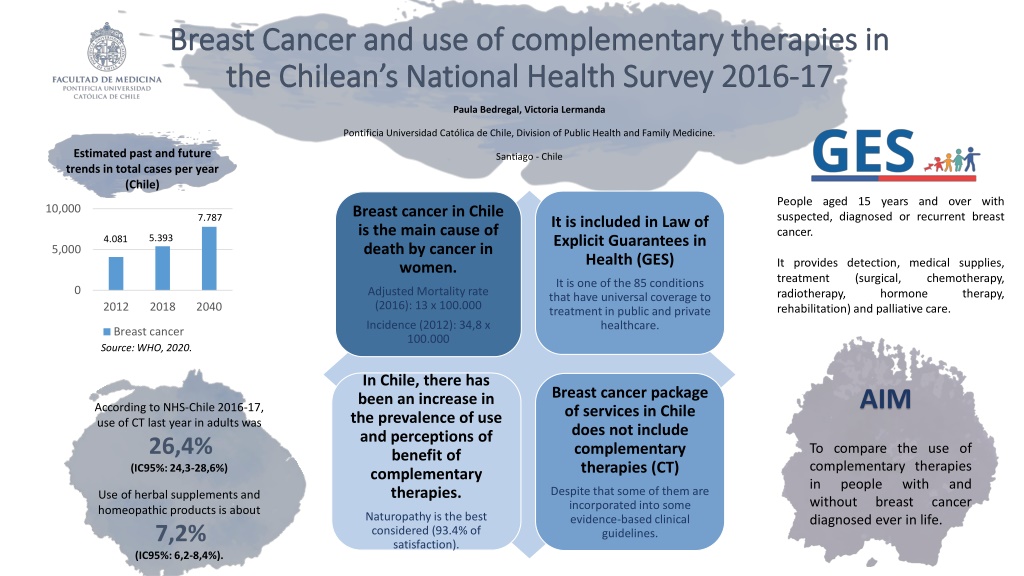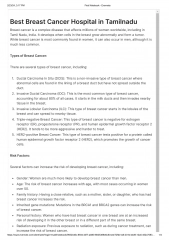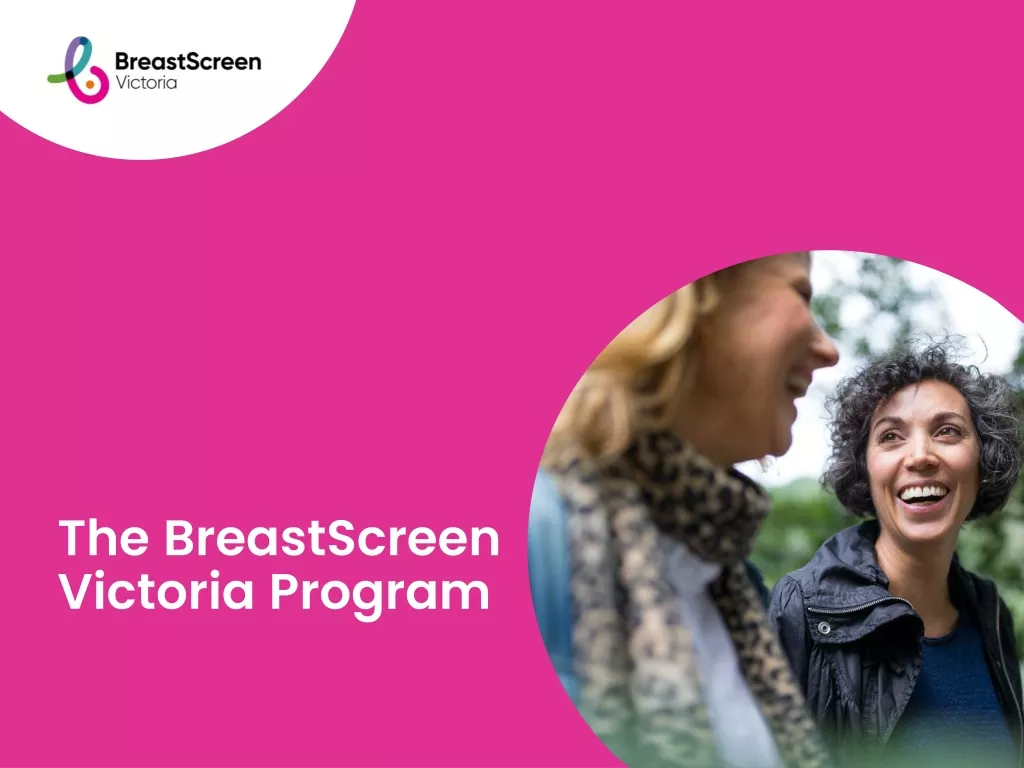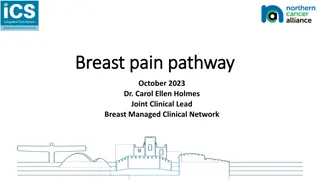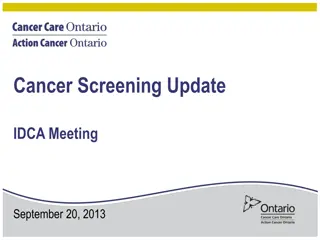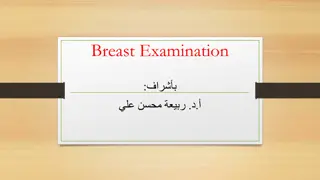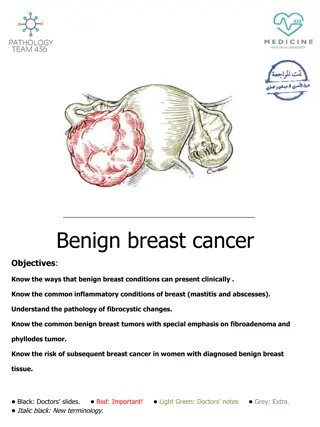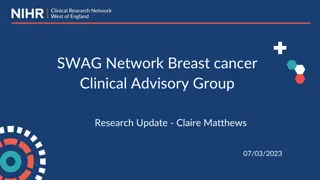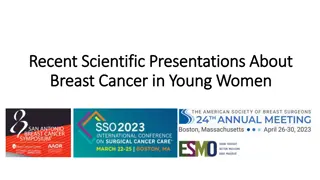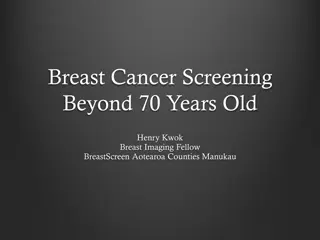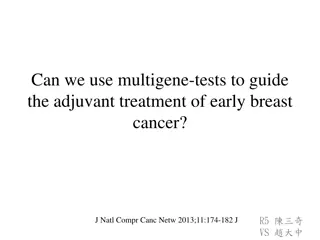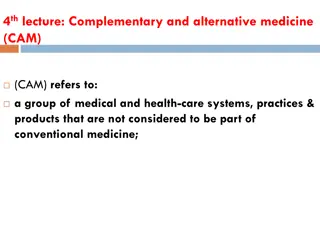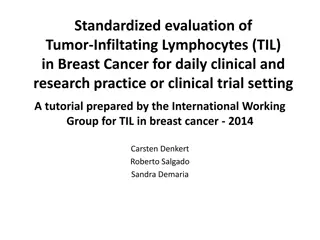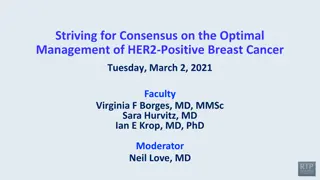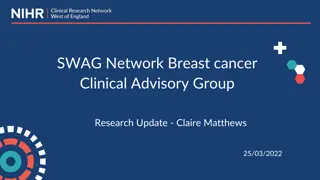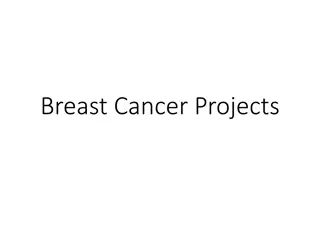Trends in Complementary Therapies Use for Breast Cancer in Chile
Complementary therapies (CT) use, including natural medicine and homeopathy, is on the rise among individuals with and without a breast cancer diagnosis in Chile. While some CTs are not included in the official healthcare package, there is increasing interest in incorporating them due to high satisfaction rates. Educational level mediates the use of CT, with those with higher education levels showing greater utilization. Research indicates a need for further evidence and consideration of integrating CT into breast cancer services.
Download Presentation

Please find below an Image/Link to download the presentation.
The content on the website is provided AS IS for your information and personal use only. It may not be sold, licensed, or shared on other websites without obtaining consent from the author. Download presentation by click this link. If you encounter any issues during the download, it is possible that the publisher has removed the file from their server.
E N D
Presentation Transcript
Breast Cancer and use of complementary therapies in Breast Cancer and use of complementary therapies in the Chilean s National Health Survey 2016 the Chilean s National Health Survey 2016- -17 17 Paula Bedregal, Victoria Lermanda Pontificia Universidad Cat lica de Chile, Division of Public Health and Family Medicine. Estimated past and future trends in total cases per year (Chile) Santiago - Chile People aged 15 years and over with suspected, diagnosed or recurrent breast cancer. 10,000 Breast cancer in Chile is the main cause of death by cancer in women. 7.787 It is included in Law of Explicit Guarantees in Health (GES) 5.393 4.081 5,000 It provides detection, medical supplies, treatment (surgical, radiotherapy, hormone rehabilitation) and palliative care. chemotherapy, therapy, It is one of the 85 conditions that have universal coverage to treatment in public and private healthcare. 0 Adjusted Mortality rate (2016): 13 x 100.000 2012 2018 2040 Incidence (2012): 34,8 x 100.000 Breast cancer Source: WHO, 2020. In Chile, there has been an increase in the prevalence of use and perceptions of benefit of complementary therapies. Breast cancer package of services in Chile does not include complementary therapies (CT) AIM According to NHS-Chile 2016-17, use of CT last year in adults was 26,4% (IC95%: 24,3-28,6%) To compare the use of complementary therapies in people without breast diagnosed ever in life. with and Despite that some of them are incorporated into some evidence-based clinical guidelines. Use of herbal supplements and homeopathic products is about 7,2% (IC95%: 6,2-8,4%). cancer Naturopathy is the best considered (93.4% of satisfaction).
MATERIAL AND METHODS Material Data from last Chilean s National Health Survey (2016-17). It allows to estimate the national prevalence of chronic diseases and use of health services. Sample 5,514 people over 15 years old. It includes 2.317 men and 3.924 women. Analysis Descriptive and bivariate analysis between age and sex. http://epi.minsal.cl/encuesta-ens/
RESULTS Comparisons 95.3% 1.2% 86% 66 10.4 Homeopathy and natural medicine are significantly the most used. There was no difference in the use of acupuncture, Bach s flowers, Reiki, Chiropractic and other CT. Received allopathic treatment related to GES Women had history of Breast cancer years old (average) Received surgery Comparison by therapy Use of 45.00% complementary therapies 40.00% 35.00% 38.10% 40.00% 30.00% 36.40% 30.00% 25.00% 26.20% 20.00% 23.10% 20.00% 15.00% 10.00% 10.00% 7.10% 5% 11.90% 11.90% 4.70% 11.20% 9.50% 2.20% 0.00% 5.00% 2.40% 8.20% 4.20% 5.40% Use of Complementary Therapies 0.00% Acupuncture Bach's Flowers Homeopathy Natural medicine Reiki Chiropractic Other CT Women with Breast Cancer Women with breast cancer Women without breast cancer Women without breast cancer
RESULTS CONCLUSIONS Associated factors High level (13+ years) Low level (<8 years) Medium level (8-12 years) The use of each type of CT is mediated educational level. by Those therapies with the most scientific evidence, as acupuncture (i.e.), are less used. Despite the restrictions in access, people with breast cancer tend to use more CT. Given the growing interest in receiving CT It would be relevantto include it in Breast Cancer package services. 24,4% 46,3% 29,3% Perceptions People are requesting CT in general. There are some sociocultural factors influenced this. Is important to generate more evidence about what and why people are seeking this type of healthcare Some economic reasons are probably at the base. Nevertheless, we need more research to affirm this. CT are not included in GES, so they don t received fundings that allow people an equal access to them. On the other hand, educational level also influences the type of CT that it is requested. Implementation research in this matter is necessary to support the creation of policies that integrates CT with the current healthcare services; also is necessary to study and analize how they can be inserted Those who received CT perceived more benefits with homeopathy and herbs, and less with acupuncture and Bach s flowers. Excluding Bach s flowers, most people would like to have access to these services at the public health sector, to guarantee continuity of care and treatment. Perception of benefits Would like to have access at the public health Acupunture Acupunture 25% 75% Bach s flowers Bach s flowers References 1. Others Others Icaza, G., N ez L. & Bugue o H. (2017). Descripci n epidemiol gica de la mortalidad por c ncer de mama en mujeres en Chile. Rev. Med. Chile; 145: 106-114. World Health Organization. (2020). Cancer https://www.paho.org/hq/index.php?option=com_docman&view=download&category_slug=4- cancer-country-profiles-2020-1&alias=51653-chile-country-profile-2020-1&Itemid=270&lang=es Del Castillo, C., Cabrera E., Derio L., Gaete F. & Cavada G. (2017). Resultados del tratamiento del c ncer de mama, Programa Nacional de C ncer del Adulto. Rev. M d. Chile; 145: 1507-1513. 100% 100% 40% 50% 2. country profile. Chile. Available on: Homeopathy Homeopathy Reiki 3. Reiki 81,8% 80% 85,7% 66,7% Natural medicine Natural medicine 87,5% 92,9% Contact: Paula Bedregal (dbedrega@uc.cl)
